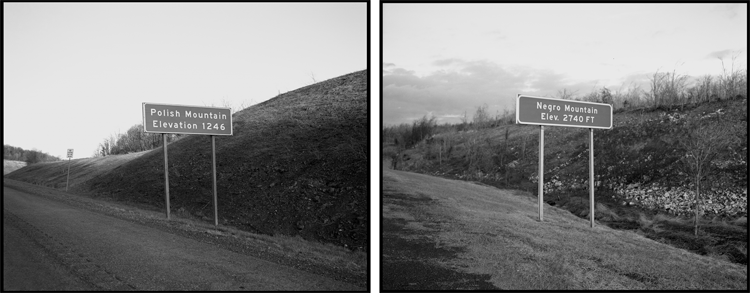
The Negro Mountain is Higher
This photograph is a diptych titled, The Negro Mountain is Higher. Both images are of actual locations I discovered while driving through the state of Maryland. Polish Mountain is in Allegany County, Maryland. Negro Mountain is in Garrett County, Maryland. As with all my work, there is a personal and social context connected to this image. While the corpus of a human presence is absence from this work, it is no less a portrait than my other work.
I became aware of these two mountains in 1992. I was in the last year of graduate school at The Ohio State University in a Master of Arts program in the Department of Photography and Cinema. I was considering entering a Master of Fine Arts program upon graduation. So I drove from Columbus, Ohio to Baltimore, Maryland to visit the Maryland Institute, College of Art and to meet and talk with graduate students studying in the MFA program there.
The route I took was interstate Route 70 East through National Highway Route 68 which becomes Route 70 East again into Baltimore through Interstate Route 95. Along National Highway Route 68, I saw the signs for Negro Mountain and Polish Mountain.
In 2003, I made images of both signs with the intention of creating a diptych that would function as a metaphor for a fact of American life that many people believe—that the mountains facing contemporary African Americans are higher than most. Coincidentally, the state of Maryland crafted a document that established a blueprint for the systemic discrimination of Africans in America through slavery and beyond. This offical edict was titled
The Maryland Doctrine of Exclusion.
The Maryland Doctrine of Exclusion was collectively written by the Maryland Colony Council in 1638, and states the following, “ Neither the existing Black population, their descendents, nor any other Blacks shall be permitted to enjoy the fruits of White society.” The doctrine was written to insure that Blacks would remain a “subordinate, non-competitive, non-compensated workforce.” While many efforts have been made to dismantle the effect of the Maryland Doctrine and the system of slavery on the lives of Black Americans, the recent Supreme Court case challenging Affirmative Action programs reminds us that there still remains a mindset that seeks to limit the movement and opportunities of African Americans in most areas of American life beyond sports, entertainment and servitude.